« July 2008 | Main | September 2008 »
August 31, 2008
Coffee Break

Katerina Golubeva in I Can't Sleep (Claire Denis - 1994)
Posted by Peter Nellhaus at 12:31 AM
August 29, 2008
Cinematic Denver: Julie Bishop

Torture Ship
Victor Halperin - 1939
Alpha Video Region 1 DVD

Action in the North Atlantic
Lloyd Bacon - 1943
Warner Brothers Region 1 DVD
Today we sail into the Denver sunset with featured actress Julie Bishop in two films with nautical themes. Julie Bishop was born as Jacqueline Wells, and appeared in films under both names. Her bigger roles were primarily in B films in the Thirties as Wells. Presumably as Bishop, with smaller roles in bigger studio productions she got a bigger paycheck. In either case, I had to review her filmography to realize I had seen Wells/Bishop in more films than I had realized. If anything, Julie Bishop, as she was best known professionally, proved that one can be a featured player in three decades worth of films, and still be easily forgotten.
Torture Ship was "suggested" by a story by Jack London. Not having read the story, "A Thousand Cuts" myself, I can't vouch for how much was London and how much was Poverty Row madness. Irving Pichel serves as an actor here, portraying a doctor who tries to modify criminal behavior through surgery. Lyle Talbot is the nephew, who has gone from being an Annapolis grad to being captain on Talbot's runaway yacht that serves as his laboratory. Wells is an escaped criminal, one of several recruited by Pichel to serve as a guinea pig. Wells claims to be innocent of her crimes, and Talbot believes her. This film acts as an argument for contemporary films where the innocent girl fakes almost everyone at the end by being truly evil. But Torture Ship was made in a gentler time for Hollywood, when the brunette with too much lipstick was to be trusted over the brassy blonde hussy.

Torture Ship has one nicely photographed moment of one of the killers checking out scalpals, with the camera looking through the glass casing, and the criminal lit from below. Otherwise, there's not much to either to story or the story telling. There's no torture either, except for the psychological kind when the criminals start getting nervous about the bad doctor performing operations on them. This is the kind of movie they use to show on network television on Saturday afternoons or very late at night, and as such probably would have looked better on a smaller screen.
Meanwhile, in Action in the North Atlantic, Bishop gets a little bit of action, approximately ten minutes in a two hour film. The saga of the Merchant Marines in World War II, Bishop is the low rent chanteuse that Humphrey Bogart seems to have promptly married after decking the jerk who gabbed during her singing. One song, a brief meeting with skipper Raymond Massey who gives the newlyweds his blessing before taking Bogart to his next mission. The film was written by future blacklistee John Howard Lawson about the combine efforts to help out our allies, the Russians. There are a few good moments of action that are probably attributable to montage masters Don Siegel and John Leicester as well as Warner house director Lloyd Bacon. There's not enough of Julie Bishop to create much of impression other than that she seemed to be the contract player called on when a love interest was needed, but the role was too small for the likes of Virginia Mayo or Ann Sheridan.

Posted by Peter Nellhaus at 12:33 AM
August 27, 2008
Cinematic Denver: Dean Reed

American Rebel
Will Roberts - 1985
United Documentary Films DVD
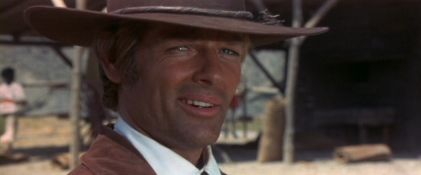
Adios, Sabata (Indio Black, sai che ti dico: Sei un gran figlio di...)
Frank Kramer (Gianfranco Parolini) - 1971
Columbia Pictures Region 1 DVD
"Nobody knows Me in My Own Hometown" may be still be the most emblematic song by Dean Reed. I missed out on seeing Reed's return visit to Denver for the screening of American Rebel in 1985 at the Denver International Film Festival. For most people, Reed was the rock and roll singer who left the United States to live in East Germany. Until I finally saw Will Robert's documentary, I did not know how popular Reed actually was in the Soviet bloc, or in South America. Nor was I aware that had I looked a little harder, I might have caught some of his acting career in Italian productions. One can only guess at what Reed's career might have been like had he not been a career expatriate. Unlike some stars of westerns, he was actually born in the west. His strong, faintly operatic voice probably would have been channelled to country music. Given his acrobatic abilities, Reed could have possibly done the kind of parts played by Burt Lancaster in his physical prime. What is known is that Reed's visit to Denver turned out not to be a re-introduction of a native son, but a farewell visit.
One of the stories about Dean Reed that is recounted in American Rebel is that as a young high school track star, Reed raced a mule, for over 100 miles, for a quarter, and won. Reed's own stubbornness in his beliefs was both his strength, and possible undoing. It was pure chance that enabled Reed to get an introduction to a Capitol Records producer, going from unknown to minor celebrity in the United States, to stardom in the countries where his peers never traveled. Even if one questions Reed's politics, the guy was absolutely fearless about performing in throughout Latin America and the Middle East. Did Yasir Arafat truly enjoy Reed's singing "Ghost Riders in the Sky"? I can't say for sure. What is certain is that Reed seemed to truly believe in peace, love, the brotherhood of man, which was his central motivation for stepping on the stage.

The one film that Reed starred in that got major distribution in the U.S. was Adios, Sabata. The third of a trilogy of spaghetti westerns, the only known name in the cast was star Yul Brynner. Reed, second billed, portrays a gambler and sometime artist, who may or may not be working with Sabata to steal a shipment of gold from the Austrians who are ruling Mexico. The gold is suppose to be for purchase of arms for the rebels, but the gang of thieves think about benefitting themselves. Had I not known who Reed was, I would have assumed with his dyed blond hair that he we an Italian or German actor with an English language pseudonym.
What cannot be denied is that Dean Reed could do his own stunts, as demonstrated by some trick riding in one scene. As far as Italian westerns go, Adios, Sabata has a few unique bits, such as a Flamenco dancing outlaw, and a scene with Reed and Brynner playing a Schubert duet on piano. The political aspects, such as they are, probably appealed to Reed. American Rebel shows more clips from Reed's other films that he also wrote and directed, including his own version of the Sand Creek Massacre, the subject of Ralph Nelson's Soldier Blue. Not surprisingly, most of Reed's other films are westerns. The excerpts provide a bit of culture shock, not so much for the location shooting in Bulgaria, but the characters speaking German. One hopes that someone will be enterprising enough to make these films available on DVD. Even though Dean Reed left Denver, Colorado, that his filmmaking mark was primarily in westerns showed that parts of Denver had always stayed with him.

Posted by Peter Nellhaus at 12:43 AM | Comments (4)
August 25, 2008
Bangkok Love Story

Pheuan... Guu rak meung waa
Poj Arnon - 2007
TLA Releasing Region 1 DVD
For those paying attention to Thai cinema, one of the bigger surprises was the commercial success of Bangkok Love Story, one of two Thai gay love stories that did well at the box office and with Thai critics. The additional surprise of Bangkok Love Story is that it was written and directed by Poj Arnon, who only half a year earlier released one of the critically least respected films of 2007. Of course audiences flocked to Haunting Me anyways. Still, who would have thought that the guy who made Thai audiences scream with laughter about fat middle aged ladyboys chased by a chubby ladyboy ghost would also make a sentimental love story about a hitman and his would-be victim.
Bangkok Love Story actually begins with the time honored first person narration of the hitman, who of course is an alienated loner. Normally Cloud's job is to shoot to kill. For what he thinks will be his last job, he kidnaps a guy named Stone. It's never clearly explained how Stone got his information or what he does exactly, but as a person who has the goods on a mob boss, he is to be eliminated. Why Stone is kidnapped instead of murdered immediately like Cloud's other victims isn't clear either. What Cloud finds out is that Stone is a person of honor, unlike the criminals that Cloud is usually after. Cloud's sense of ethics forbids him to shoot Stone, and the two make a run for it. The gangsters that Cloud works for have a warehouse full of Buddhist statues, an unusual location for a shoot out. What makes the scene even stranger is that this is a commercial Thai film, released without problem by the same censorship board who went apoplectic over a guitar playing Buddhist monk in Sydromes and a Century.

Stone nurses the the wounded Cloud back to health in Cloud's hideout, a penthouse in an abandoned building. The man who was introduced with his cutie pie wife looks longingly at Cloud, taking advantage of the illness to undress Cloud and wash his naked body. Cloud gets healthy enough to bathe himself but Stone offers to wash Cloud's back. Of course Stone washed more than Cloud's back, and the two start smooching before doing the hibbidy dibbidy. Cloud soon sends Stone away, to walk home to his mansion wearing nothing but his form fitting tighty whities. Stone's wife, Sand, can not understand why Stone has been distant with her. It isn't until she see Stone and Cloud get up close and personal in the rain that she knows the truth about her husband. In the following scene, Sand wonders how she was so oblivious to the wedding videos of Stone holding hands with his best man.
What struck me about Bangkok Love Story is that the man who got some cheap laughs from a parody of Brokeback Mountain made a film that has succeeded with audience and critics, a gay love story that will probably be parodied by other Thai filmmakers, if it hasn't been already. The mawkishness of Bangkok Love Story is stressed by the gushing strings. Imagine, if you will, a vintage Warner Brothers weepie, with Leslie Howard leaving Bette Davis for Humphrey Bogart, to the musical accompaniment of Max Steiner. The effect is an overload of melodrama and beefcake. I could be very wrong about this, but I think the real audience for Bangkok Love Story is actually girls who like to see man on man action. As a sometimes chronicler of Thai films, I do find it encouraging that a new Thai film that is neither a ghost story nor martial arts adventure has a DVD release in the U.S. Now if only Love of Siam, Me . . .Myself and Ploy will follow . . .

Posted by Peter Nellhaus at 12:00 AM | Comments (8)
August 24, 2008
Coffee Break

Emmanuelle Riva in Hiroshima, Mon Amour (Alain Resnais - 1959)
Posted by Peter Nellhaus at 12:07 AM
August 22, 2008
Movies about Movies Blog-a-thon: H Story

Nobuhiro Suwa - 2001
Panorama Entertainment Region 3 DVD
It has been over thirty years since I had seen Hiroshima, Mon Amour. Since I had decided to write about H Story, it seemed necessary to revisit the source of inspiration. While I had recalled that part of the film, like the novels of Marguerite Duras, was about the veracity of memories, I had forgotten completely another part of the film. Emmanuelle Riva portrays an actress who is in Hiroshima to make a movie about Hiroshima, specifically about the event that literally shook the world. For a few minutes, Resnais films the filming of that movie. Within the context of H Story, not only is it a movie about making a movie, but additionally it is about remaking a movie that itself was partially about filmmaking. The mobius strip doesn't stop there, though.
H Story is additionally about the physical nature of film. For a while there is a visual distinction between the main narrative and the film being made with use of different film stocks. Eventually that distinction is lost. Parts of scenes including those with dialogue, are without sound, and the flare of exposed film is seen more than once. In these ways, H Story is self referential, more so than other, similar films. The device is more closely analogous to that of a novelist like Tom Robbins who breaks off from the storytelling to digress on the act of writing.
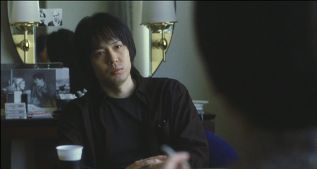
The main narrative is about the attempt to remake Hiroshima, Mon Amour. The bulk of the screenplay in the film within the film is from Duras' screenplay. The director, portrayed by Suwa, discusses having Resnais' film stay in his mind in a discussion with the screenwriter, portrayed by actor and writer Kou Machida. (Suwa was also the writer of the H Story screenplay.) There are cuts to stills from Hiroshima, Mon Amour and one can also see a still in the background when Suwa and Machida discuss the film Suwa is trying to make. While some of the scenes of the film in progress roughly duplicate the original film, others do not. For the most part Suwa declines to repeat the formalism of Resnais. Suwa does apparently have a shot of Beatrice Dalle and Machida follow the same path as Emmanuelle Riva and Eiji Okada in a shopping area of Hiroshima. Attempting to film a scene at a bar, Dalle balks at repeating the dialogue from the original film and complains that Suwa's remake is a "carbon copy". The filming appears to have been completed, but Machida gets a message, while he and Dalle are at the beach, that Suwa has decided to abandon the film.
One of the other distancing devices Suwa employs is having his actors in contemporary clothing while filming the remake. We have the incongruous sight of Dalle sporting a tatoo on her shoulder while discussing World War II with Hiroaki Umano, taking the Okada role. While Suwa also uses color documentary footage of the aftermath of the bombing, it is more abstract, more of a scenic view, without the footage of deformed or injured people that was used by Resnais. It should be remembered that Resnais, like Suwa, a former documentarian, was also interested in the appearance of truth, and used staged footage from the feature Children of Hiroshima.

Where Suwa goes further than Resnais is in exploring the bombing of Hiroshima as the subject and inspiration for art. Dalle mentions visiting the museum that features artifacts from the bombing, her only contact with the city during the shoot. She and Machida visit a museum of modern artwork inspired by the bombing. The scene recalls Peter Cowie's commentary on the Criterion DVD of Hiroshima, Mon Amour about Hiroshima having been turned into a sort of theme park. Even for Suwa, or at least his onscreen self, Hiroshima is just the city he was born in, with the historical significance part of the background.
If Hiroshima, Mon Amour is, like other works by Duras, about memory, H Story is about not only about how history is remembered, but remembering movies. That some of the scenes are staged differently by Suwa may be indicative of how those scenes appeared in his memory. That we see the film within the film with the camera sometimes going in and out of focus, with brief interludes of silence, and with the light flares, is all part of the fragility and faultiness of memory.
For more movies about movies, visit Goatdog.

Posted by Peter Nellhaus at 12:12 AM | Comments (1)
August 20, 2008
Team Picture

Kentucker Audley - 2007
Benten Films All Regions DVD
There is something that Team Picture gets right that hardly seems to happen in movies. In a couple of scenes we hear the sound of summer in the country. Even with the two speaker sound coming out of my television was the overwhelming aural symphony of crickets and other insects. Maybe the moment seemed so extraordinary because films in general have gotten noisier, and people in general, not just filmmakers, have lost the ability to appreciate not only silence, but unadorned ambient sound. Kentucker Audley also has two moments of total silence, allowing the images to speak for themselves, showing a trust in the viewer that seems to have been lost by many mainstream filmmakers.
The film's setting is the Memphis of cheap rental houses, during a summer spent in part lounging in inflatable wading pools, sipping PBRs. David and Eric are two friends who share a house. Both have a tendency to be self-absorbed. David is unaware of his girlfriend's art exhibit, or of her feelings prior to the opening of the show. His lack of recognition of her feelings is the spur for her to end their relationship. Eric, comically clueless, calls up a young woman whose number he as obtained indirectly, initiated a relationship that he misreads as romantic. David quits his job at a sporting goods store, and drives the girl next door to Chicago for the weekend, a tentative friendship that momentarily hints at becoming something more.

Without putting too fine a point on it, Team Picture has a narrative that play out like Antonioni in small city America. Sure, no one is a sophisticated or beautiful like Alain Delon and Monica Vitti, but at its essence is the story of men and women not totally certain of themselves, or may too certain for the wrong reasons, briefly coming together before drifting apart. Unlike the formality of an Antonioni film, Kentucker Audley's observations of his characters is casual in its observation of how people interact. There is no effort to be dramatic in the theatrical sense, nor does Audley have the need to make his film longer than an hour. What needs to be expressed is done without extra emphasis or adornment.
There is one wonderful shot that would be worthy of Yasujiro Ozu in its simplicity, had Ozu deigned to shoot from a crane, or more likely, a ladder. The camera looks down a the lawn, the wading pools removed, dragged away for storage. We see the rings of flattened grass where the pools were set, and an abandoned yellow ball. Without needing to show anything else, this is the perfect image of the end of summer.
I also should add that the brief running time of Team Picture works to its benefit for a more personal reason. Unlike many films that can can be assessed in one pass, I saw Team Picture once, let a couple of days pass, and viewed the film a second time. Team Picture is antithetical to what currently passes for mainstream filmmaking, and needs to be appreciated on its own terms.

Posted by Peter Nellhaus at 12:51 AM
August 19, 2008
Cinematic Denver: Debra Paget

The River's Edge
Alan Dwan - 1957
20th Century Fox Region 1 DVD
Happy 75th Birthday, Debra Paget!
If there was ever an actress who truly defined starlet, it could well have been Debra Paget. For almost seven years, Paget was the go-to girl for the role of the princess, Native American, Egyptian, or just plain ingenue. At the age of 16, Paget played wife to James Stewart, the first of a series of much older screen husbands. Elvis and Richard Egan fought over Paget in Love Me Tender. As consistently as Paget worked, she never became a true star. When she did receive top billing in a very good film, it was never seen as intended by American audiences. Fritz Lang's Indian films are throwbacks to the kind of work he had done at the beginning of his career in the Twenties. While some may gripe that Paget's role should have been done by an Indian actress, the films are the best of her relatively short career, and the ones that made the best use of her abilities. The Fox films are interesting to see as more representative of her work, although Paget's role in her last film for the studio is atypical.
One of the first things wrong with The River's Edge is that there is no river. It more of a furious stream. Someone thought that the film should be made exactly as written and because the character is described as a redhead, the normally brunette Paget has one of the worst dye jobs ever. This was Paget's last film at Fox and in the beginning of the film she is presented as badly as possible with faded carrot color hair and a pair of shorts with one leg riding much higher than the other. Paget's hair and costume improve later, even if her perfomance doesn't.

Paget plays the ex-con wife of rancher Anthony Quinn. Former partner in crime Ray Milland shows up the New Mexico ranch, looking to hire Quinn as his guide across the Mexican border, with plans to reunite with old flame Paget. Milland is carrying a suitcase full of enough bills for early retirement. Milland and Paget's plans to take off, leaving Quinn behind, collapse after Milland accidentally on purpose runs over a highway patrolman with his pink Thunderbird. Paget still feels that Milland is her one and only even after he attempts to run her over, the T-bird gunning towards Paget in a corn field, briefly a "South by Southwest". Quinn guides the two through a mountain pass, while Paget eventually realizes that the simple minded big lug is the guy for her. Paget hurts her arm, Quinn hurts his leg, and Milland almost gets away with the loot until it gets away from him.
The efforts of film scholars James Ursini and Alain Silver on the commentary track still couldn't convince me that The River's Edge is more than mildly entertaining hokum. One little piece of interesting of information was that Dwan may have written the script as well as others credited to his frequent editor, James Leicester. There is also some discussion on the sexual elements that Dwan liked to insert when possible with his films. In the case of The River's Edge, the audience is teased with shots of a bra falling to the floor, bathtub and shower scenes, and Paget's wearing nothing but a robe. If you want to see more of Paget in a much better film, the Lang films will fit the bill. The River's Edge stands as Fox's odd send off as the studio sweetheart was transformed briefly into a rural femme fatale.

Posted by Peter Nellhaus at 12:48 AM | Comments (1)
August 17, 2008
Coffee Break

Allen Baron in Blast of Silence (Allen Baron - 1961)
Posted by Peter Nellhaus at 12:25 AM
August 16, 2008
Cinematic Denver: Douglas Fairbanks

Reaching for the Moon
Edmond Goulding - 1931
Passport Video Region 1 DVD
Denver seems to have always had a problem with its own history. Whether this involves preserving older buildings or paying tribute to famed residents, it usually seems to involve efforts from non-Denverites to point out the value in the past. My first knowledge that Douglas Fairbanks had anything to do with Denver was by chance while I was at high school, a little over forty years ago. Someone had mentioned that Fairbanks had attended an earlier incarnation of Denver East High School. It was also mentioned that he grew up at a house nearby, near the intersection of Colfax and Josephine Street.
I think I had seen some stills of Fairbanks, and had I seen any of his films, it may have been an abridged version shown on the short lived television series, "Silents, Please". I could never find out which house was the one Fairbanks grew up in. I tried to find more information from Douglas Fairbanks, Jr. when he came to visit Denver, but he didn't know either. (Not that the evening was a bust, as I still had the pleasure of seeing The Exile again on a theater screen.) I would have thought a little bit more might have been done on the 100th birthday of Fairbanks' birthday in Denver, but there seemed to have been little interest in cinema's first action hero. As for East High School, in addition to Fairbanks, it should be proud of having Hattie McDaniel as a student. I would think that being the first African American to win an Oscar should make up for the fact that she dropped out of school. East High School currently can also brag about past graduates Pam Grier and Don Cheadle. And if you find Going Ape! on a late night broadcast, that's my sister playing a corpse, doing her best to keep from cracking a smile.

Reaching for the Moon almost describes Fairbanks' career at the beginning of the sound era. The title is the same as a film directed by John Emerson, also starring Fairbanks, from 1917. In the newer film, Fairbanks' character, Larry Day, is described as a young man. Fairbanks, was forty-seven in 1930, and looked his age, albeit a very fit forty-seven. What had not diminished was his on-screen enthusiasm and likability. Larry Day is a wealthy stockbroker pursued by aviatrix Vivien Benton. Benton captures the heart of the long time bachelor, and Day ignores business to pursue Benton on an ocean liner bound for England. The film isn't completely Depression era escapism, as Day loses everything he has financially, only to learn that Benton loves his him for himself. Day's financial free fall is cushioned by Benton being independently wealthy herself.
Fairbanks show off his athletic ability mostly in leaping into bed, and running around the ocean liner without a shirt. More rewarding to watch are the fantastic art deco sets by William Cameron Menzies. The historically minded may want to see Bing Crosby's first film appearance, prior to the more intimate kind of singing he was known for. There is also some amusement to be found in the pre-Code gay humor when valet Edward Everett Horton demonstrates to Fairbanks how to put the moves on Bebe Daniels. The DVD version is apparently the surviving version of a film that had a running time of about ninety minutes. The film was made two years before director Edmund Goulding hit his stride with Grand Hotel. As an early talkie, there are some indications that Goulding was experimenting with sound and moving the camera as the film progresses, most clearly in several traveling shots on the ocean liner set. I don't know if Douglas Fairbanks could have re-invented himself for the sound era, or if he really wanted to, but Reaching for the Moon describes a film career that took off like a rocket, and almost as quickly fell back to earth.

Posted by Peter Nellhaus at 12:17 AM | Comments (1)
August 14, 2008
Re-Cycle
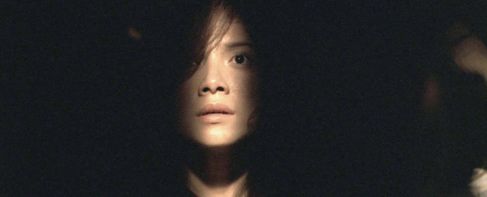
Gwai Wik
The Pang Brothers - 2006
Luminous Velocity Entertainment 35mm film
While waiting for a release of their remake of their own Bangkok Dangerous, I took advantage of seeing this earlier film by Danny and Oxide Pang theatrically. I've admittedly been a fan since the time I saw the original The Eye. Like The Eye, Re-Cycle has the same star, Angelica Lee, and combines a primarily Hong Kong cast in the speaking parts with extensive location shooting in Thailand. Admittedly, aspects of this film have been, excuse me, re-cycled, especially a plot point that's become something of a cliche associated primarily with Luigi Pirandello.
Lee plays the part of a writer famed for her best-selling romance novels. At the press conference for the release of a movie based on one of her books, she announces her plan to write a book in a more supernatural vein. When asked about the main female character in her romance novel, Lee admits that the creation may be unconsciously a part of herself. During the press conference, a former lover, not seen for eight years, appears. For Lee, what is desired is a total break from the past. It is while she is writing at night that one of the apparitions she is writing about seems to appear.
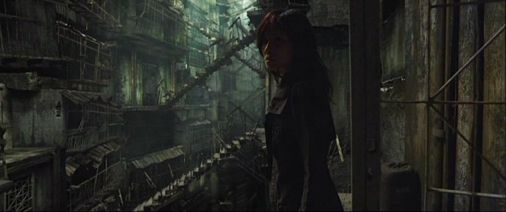
The Pangs prove that they have more to offer than redoing the familiar tropes of the Asian horror film. With tongue firmly in cheek we have the mysterious phone calls, the overflowing bathtub, the strange neighbors, and some strands of someone's long black hair. Just when the film seems to be revisiting familiar territory, with Lee walking done a long, dark and very spooky hallway, she finds herself in a very forbidding alley surrounded by crumbling buildings, and people . . . or are they human. It doesn't take a lot to realize that this nightmare journey is through a landscape imagined by Lee. One of the more visually stunning sets is of an area filled with abandoned toys, some of them giant sized. The scene resembles a live version of one of the sets in the anime Paprika, only worn and dilapidated. The people in this nightmare landscape are people from Lee's past since forgotten and imagined characters from abandoned writing.
A part of Re-cycle which may court some argument is in regards to a scene involving abortion. While the stance of the film is pro-life, it is not couched within the Christian framework. That this nether world is populated by people both real and imagined does not make literal sense although it works within the framework of a dream. Within a broader view, one could interpret the film as being about reconciling oneself to those least comfortable parts of one's past, and perhaps making peace with personal demons.
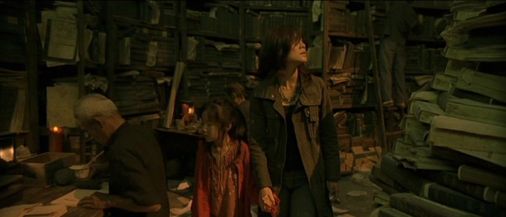
Posted by Peter Nellhaus at 12:55 AM
August 11, 2008
Cinematic Denver: Barbara Bates

Let's Make it Legal
Richard Sale - 1951
20th Century Fox Region 1 DVD

Quicksand
Irving Pichel - 1950
Image Region 1 DVD
The biggest irony of Barbara Bates career is that she is best known for a very small part in what was one of the biggest films of its year. Briefly appearing near the end of All about Eve, Bates plays the "new Eve" as it were, hoping to follow in the high heels of Anne Baxter, much as we have seen Baxter follow Bette Davis.
Bates never became a star even on the level of Baxter. Released one year after Eve, Bates and Marilyn Monroe are again in the same film with more prominent billing. Bates is third billed with Monroe fifth, and Robert Wagner in between. There is a shot of Monroe and Bates together, with Bates watching Monroe converse with her "patron", Macdonald Carey. Out of the context of the film, it is almost as if Bates is watching Monroe prepare to walk away with any dreams of stardom held by the more demure actress. Of course it doesn't help that Bates plays a young wife and mother who always claims helplessness, a brat in the body of a woman. There is nothing in Let's Make it Legal to explain why Robert Wagner is in love with this woman.
What few moments of the film are worth watching are primarily due to the smart aleck dialogue of F. Hugh Herbert and I.A.L. Diamond. The casting is of stars at the crossroads, with the main actors on their way down intersecting with a supporting cast on their way up. As if to remind the audience of Claudette Colbert's main claim to fame, the shot that introduces her is of her legs. Colbert is divorcing hotelier and gambler Carey, and pursued by old beau Zachary Scott. Bates is trying to keep the family together while Wagner thinks everyone would be happier apart. Only seventy-seven minutes long, this trifle comes to life during Monroe's brief appearances. If Joseph Mankiewicz's films at this time are champagne, Let's Make it Legal is a less than bubbly ginger ale.

Quicksand offers further proof that Barbara Bates was best in small doses. Hitting 30 but still looking youthful, Mickey Rooney is a garage mechanic who has dumped long-time girlfriend Bates to play the field. The new cashier at the diner catches his eye, and Mickey immediately makes a date. The new girl is played by James Cagney's little sister, Jeanne. Like her famous brother, Jeanne Cagney is a real tough cookie and almost as pretty. Borrowing a twenty dollar bill from the garage cash register to pay for the date escalates to robbing a drunk, theft from a penny arcade, stealing a car and attempting murder, all within one week in which Mickey's life dives into hell in the proverbial handbasket.
Bates plays one of the sappiest women in film history, on constant standby for Mickey, in spite of the broken dates, unanswered phone calls, and newly established criminal record. Bates baby-faced brunette provides a visual contrast to Cagney's hard, lean blonde.
What Quicksand does offer is a tight little noir, a low budget exploration of cheap people with cheap ambitions, all within the tattered confines of Santa Monica. Besides a relatively subdued Rooney, the best performance is Peter Lorre as the arcade owner who was the former employer, and perhaps lover, of Cagney. Fun too, is spotting a brief appearance by newcomer Jack Elam as a bar patron. Cinematographer Lionel Lindon probably should get the credit over director Irving Pichel for the visuals - nighttime shots in the streets of Santa Monica, and a dynamic chase in and around the Santa Monica pier.
Following her performance in Quicksand, Barbara Bates jumped to the big leagues as a Fox contract player. Even if Bates had not been plagued with emotional problems, I suspect that her career would have still followed an identical path, only with more television guest roles as she got older. If Bates' film career was ephemeral, sadder is that her life was too short as well.
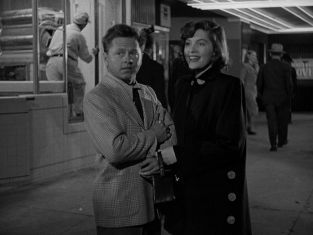
Posted by Peter Nellhaus at 12:39 AM
August 10, 2008
Coffee Break
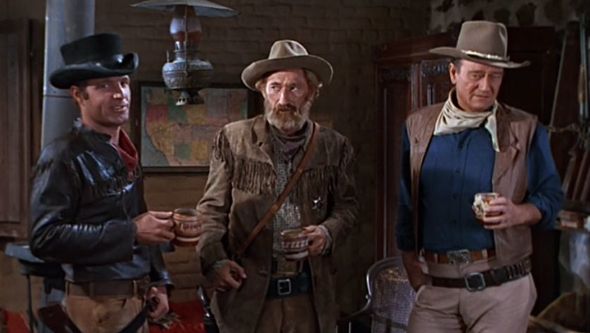
James Caan, Arthur Hunnicutt and John Wayne in El Dorado (Howard Hawks - 1966)
Posted by Peter Nellhaus at 12:56 AM | Comments (1)
August 08, 2008
Anne of the Indies

Jacques Tourneur - 1951
Resen Entertainment Region 2 DVD
For this date of 8/8/08 I thought of pieces of eight which of course made me think of pirates. Anne of the Indies is a reminder that Hollywood could occasionally make a good action film starring a woman, even during a supposedly more benighted era. It's too bad that this film is only available as an import DVD at this time as I would think there would be many girls who would delight in seeing Jean Peters take on some big, burly men, with her sword.
Inspired by the real life Anne Bonny, Anne of the Indies is in part a film about family. Taking the name of Anne Providence, the title character seeks revenge against the British for the death of her brother. The pirate known as Blackbeard has served as her surrogate father. The man she falls in love with is secretly married. A search for treasure evolves into the breaking of trust, loss of alliances, and the self-destruction of Anne.

While Anne of the Indies has some of the trappings of a traditional pirate film with the sword fights, rum drinking, and ship battles, it fits in with Tourneur's films thematically. As pretty as this film is in ripe technicolor, Anne, like other Tourneur protagonists, descends into her own kind of madness. In several Tourneur films, the narrative is of a character who begins with a relatively stable sense of the world and their place in that world, only to find that they are overcome by circumstances that challenge that reality. The protagonist either finds their way out of an impossible situation, often a trap of some kind, or dies, surrendering to that new reality.
In this film, Jean Peters allows herself to be undone, making herself vulnerable to the charms of Louis Jourdan. The film for a time seems to endorse Peters' temporary discarding of male clothing, and her temporary discarding of her authority as ship captain, suggesting that all that was needed was the more genteel Jourdan to bring out Peters' femininity. As it turns out, Jourdan is married to the more feminine, and traditionally prettier, Debra Paget. Tourneur is ambiguous regarding Jean Peters' character, so that she defies a traditional interpretation. In some ways Peters character is like that of Simone Simon in The Cat People in that they can be defined as going against nature from one perspective, yet from the point of view of the character, it is that non-conforming nature that is their survival mechanism. The film suggests female vulnerability with the first sea battle described by the British captain as a frontal attack, and with the first close-ups of Peters showing her removing her jacket to reveal bleeding to her doctor, played by Herbert Marshall. In a scene where Anne tries on a lace dress, she finds herself both tied up and confined, the dress representing how women are ideally seen by men. With Anne demonstrating her skill with gun and sword equal, if not better, than the other men, the film invites a more thorough, and feminist reading. The use of water as a metaphor for the female is a component of the films ending, with Anne alone at sea, about to be engulfed by the feminine. Yet the final, brief image, is of Anne triumphant in spirit, if not in body.

Posted by Peter Nellhaus at 12:41 AM | Comments (4)
August 06, 2008
Belphegor: Phantom of the Louvre
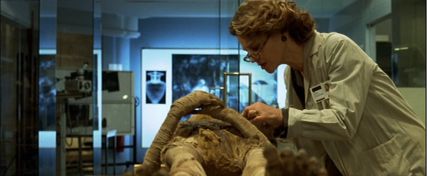
Belphegor: Le Fantome du Louvre
Jean-Paul Salome - 2001
Lionsgate Region 1 DVD
Belphegor is proof, should anyone need it, that I will watch Julie Christie in just about anything. The film is based on a novel which was also the source of a French mini-series officially. I can't vouch for any previous tellings of the story, but the film I saw combined elements from The Mummy, both the original by Karl Freund and the CGI version by Stephen Sommers, plus Ghostbusters and The Exorcist. That the film is French doesn't make it any better. Even a brief nude shot of Sophie Marceau does little on behalf of this time waster.
Christie plays an English Egyptologist who come to the Louvre to help identify a mummy found about seventy years ago. The spirit of the mummy flies in and out of Sophie Marceau who conveniently lives right across the street from the Louvre. The film starts off with some shots of the Sphinx, its face shot off by Napoleon. Even though the story is mostly about this mummy wanting to regain its needed artifacts for his journey to the underworld, I had to think that maybe it was payback time for France. As if anyone missed it, a character even mentions the various Egyptian artifacts in Paris, plus the pyramid at the Louvre.
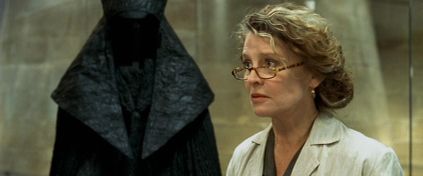
Christie gives this film more class than it deserves. The best parts are of her flirting with police inspector Michel Serrault. Christie is more seductive with a glance than Sophie Marceau can achieve with her entire body, so much so that the mature would-be lovers are more interesting to watch than the younger stars. Juliette Greco also appears briefly for those who may be interested. Strangely, that is Christie speaking French in the French language version, but not her in the English language version. Most damning of all is that I actually nodded out a couple of times while watching Belphegor. But, hey, Julie Christie's in it!
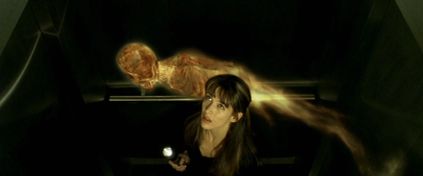
Posted by Peter Nellhaus at 12:40 AM | Comments (2)
August 04, 2008
Insee Thong

Mitchai Banchaa - 1970
Triple X Region 0 DVD
I can't possibly improve on the notes that come with this DVD: Rome Rittkikrai (Mitr Chaibancha) the real Red Eagle had to disguise himself as The Golden Eagle, just to hunt down Bhoowanai (Kanchit Kwanpracha) the fake Red Eagle, who was having plans to destroy the country. Rome, by the help of Vasana (Petchara Chaowarat) also had to conquer the Red Bamboo gang which was led by Bakin (Ob Boontid). And in the final scene, Vasana would have to pick up Rome Rittkikrai, in the Red Eagle costume just to proof that the real Red Eagle is still alive. And this is also the last scene in the real life of Mitr Chaibancha because of the unexpected accident that took away the greatest actor of our time on October 8th, 1970.
Insee Thong is a key film to understanding Thai cinema. One of the surviving examples from the "Red Eagle" series, it's a film to be seen to more fully appreciate homages past (Michael Shaowanasai and Apichatpong Weerasethakul's Adventures of Iron Pussy) and future, with Wisit Sasanatieng planned "Red Eagle" film starring Ananda Everingham. The film is timely to watch due to some similar circumstances with a currently popular film. In the case of Insee Thong the star was both a masked hero and a joker. His accidental death during the filming of the final shot gave the film a mythic status that still exists in Thailand almost thirty years later. How big a star was Mitr Chaibancha? The DVD includes footage of his funeral which was open to the public. The crowds may not have been the size of that for Rudolph Valentino, but by any standards it was still huge. The original film reportedly included footage of Mitr's fall from the helicopter rope ladder that flies into the sunset. The DVD ends with a freeze frame with titles (in Thai) explaining that the final shot of the film was also the final footage of Mitr. Amazingly, Insee Thong was released slightly more than a month after filming was completed.

The print that the DVD used as source material must have played in every Bangkok grindhouse. It's hard to know if the color scheme dominated by green and pink was deliberate, or part of the general fading of the print. Add to that, scratches and a few jump cuts, all of which adds to the sense of a genuine movie going experience.
I would go as far to say that, except that it's in Thai, and roughly made my Hollywood standards, it has everything current audiences are looking for in a movie, and more. Aside from Mitr as a masked hero, Petchara shows she can handle herself as well when needed. Bakin is capable of having his spirit manifest from red glass Buddhas, causing his victims to be "heart attacked". I can't say for certain how accurate the translation of the subtitles are, but as I understood it, Bakin studied hypnotism under Rasputin and is able to divide himself into up to three unkillable apparitions. At one point, a police detective cross dresses to infiltrate a gang of ladyboy criminals. Mitr's hearty laughter is topped by the chortling of the bad guys. There's also the teensiest bit of titillation with the introduction of a kidnapped scientist's daughter wearing nothing but a very short nightgown.
For those who don't speak Thai, there are only a few examples of Thai cinema from before the "Thai New Wave" and more recent action and ghost films, available on DVD. The concept of film preservation is still debated in Thailand. Add to that, a lack of interest in making even some basic information available on the Internet Movie Database which seems more concerned with having technical staff than film scholars on their payroll. For someone like myself who has affection for Thai cinema, finding Insee Thong on DVD is like finding a lost treasure that may be worse for wear. What the film may lack in polish and professionalism, it more than makes up for in unabashed enthusiasm.

Posted by Peter Nellhaus at 12:46 AM | Comments (1)
August 03, 2008
Coffee Break

Paul Douglas and Ann Southern in A Letter to Three Wives (Joseph L. Mankiewicz - 1949)
Posted by Peter Nellhaus at 12:52 AM | Comments (2)
August 01, 2008
Cinematic Denver: Gene Fowler, Jr.

I Married a Monster from Outer Space
Gene Fowler, Jr. - 1958
Paramount Region 1 DVD

The Rebel Set
Gene Fowler, Jr. - 1959
Alpha Video Region 1 DVD
With the circus, er, Democratic Convention coming to my town at the end of this month, I thought I would have some postings on some film people born in Denver, and maybe a couple of films shot here, during the month of August.
It may have been genetic that the two most famous films directed by Gene Fowler, Jr. have titles that could have been the screaming confessional headlines found on a tabloid newspaper. I Married a Monster from Outer Space and I was a Teenage Werewolf almost tell the entire story in a few words. Gene Fowler, Jr.'s father was Gene Fowler, famed journalist for "The Denver Post", who never let the truth get in the way of telling a good story. With a famed newspaper man for a father, it should be no surprise that as a film editor, Gene Fowler, Jr. worked with another tabloid journalist turned filmmaker, Samuel Fuller. The other significant collaboration for Gene Fowler, Jr. was as the editor of choice for Fritz Lang.
That Fowler worked with two of the more famous names associated with some of the darker films of the Fifties should put his two best known films in perspective. I don't think it is much of a stretch to describe Werewolf and Monster as film noir for teenagers. Just as Lang and Fuller made films primarily for adults addressing the anxieties of the time, Fowler's films could be seen as less directly discussing the emotional turmoil of their intended audience. Werewolf is an exaggerated version of being an adolescent male, with the uncoordinated physical changes, emerging body hair, and screaming hormones with no where to go. The "I" of Werewolf was every guy watching the film, with lust for Yvonne Lime, or her real life equivalent, and not quite knowing how to let her know that you want to be more than just friends.

Monster deals with an even scarier thought, what it means to be an adult. The film starts of with a bachelor party, actually just a few guys at a table in a bar. Bill, the one getting married the next day, stops his car when he finds what appears to be a dead guy in the road. Touched by an appendage that is clearly not human, or of a recognizable animal, his body is covered by smoke which disappears. Bill shows up late for his own marriage to Marge, distracted, or if a bad pun is allowed here, "spaced out". Much of the film's narrative owes a big debt to Invasion of the Body Snatchers. Stripped of the science fiction and horror elements, Monster can be seen as similar to so many other films where one spouse discovers a horrifying truth about the other, accompanied by feelings that the person they married is now a stranger. While a conventional reading of the title would make the "I" of the title, Marge, one could also read the title from Bill's point of view. It is he who travels through galaxies with the hope of keeping his life form from becoming extinct. That Marge, first unknowingly, acts in ways that threatens Bill's existence could be interpreted as monstrous. Whatever marriage might ideally be, it is also a trap loaded with issues ranging from sexual performance, fertility, to dealing with the expectations of friends and family. Even if your spouse doesn't come from the Andromeda galaxy, marriage can still be a scary experience.
Away from the fantasy of Werewolf and Monster, the film The Rebel Set offers fewer pleasures. The title would indicate a film about beatniks, but most of the film is heist thriller that does some petty theft of its own with elements taken from Treasure of Sierra Madre and Asphalt Jungle. The best reason to see this film in its current smeary DVD form is for the kick of seeing Edward Platt play against type. Best known as James Dean's policeman pal in Rebel without a Cause and the Chief in the "Get Smart" television series, the bearded Platt is the owner of a coffee house that serves as a front for his criminal activities. Platt recruits three men, a failed writer, an actor looking for his first break, and the criminal son of a movie star, to enact his robbery of an armored car because they are not beatniks. Later, Platt shaves the beard to be disguised as a killer priest, sometimes spouting pieties while dispatching anyone in his way. It may not make The Rebel Set that much better, but a sharper version might have been nice considering that the cinematography was by Karl Struss, his third from final film. There are fleeting moments, especially in the final chase scene, that suggest the work of someone who was once associated with Griffith and Murnau. Beatniks are peripheral to this film, only to be seen at coffee house featuring some passable faux jazz composed by Paul Dunlap. There is one character, a poet named King Invader, probably modeled after beat stand up monologist Lord Buckley, played by supporting player I. Stanford Jolley. His scene is of his attempts to recite his poetry with the jazz band while constantly interrupted by a square in the audience. The more interesting theft to take place in The Rebel Set is of those brief moments when Jolley steals this show.

Posted by Peter Nellhaus at 12:45 AM | Comments (1)
